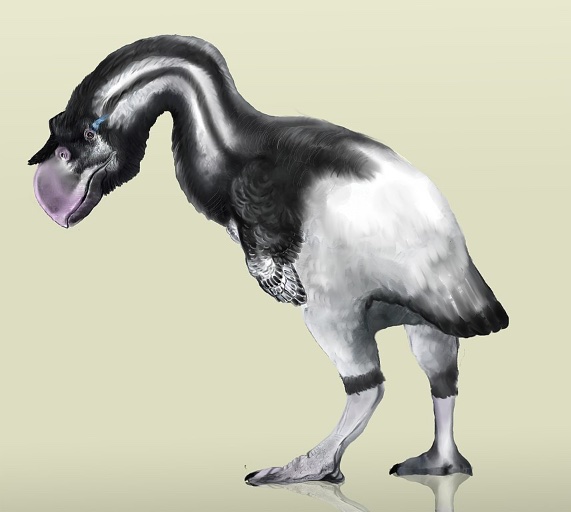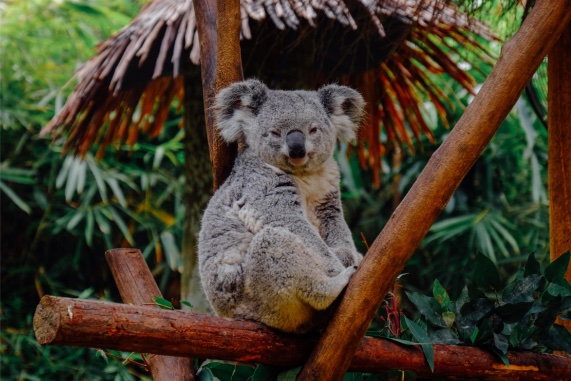In Australia during the Upper Miocene, some eight million years ago, there lived a bird that no one would have wanted to cross paths with. Dromornis stirtoni, also known as Stirton’s Thunderbird —belonging to the extinct genus of the dramatically named Demon Duck of Doom—, could reach three metres in height and half a tonne in weight. This feathered beast related to ducks and chickens, and obviously flightless, sported a hefty half-metre beak that could have shredded almost any creature, although it is thought to have been preferentially herbivorous. Palaeontologist Trevor Worthy has described it as “an extreme evolutionary experiment”, which he attributes to environmental conditions in Australia. In fact, this and other large islands have been the sites of curious evolutionary experiments that never existed or were cut short on the large continents. But why on the large islands? Is there a reason why these places have been natural evolutionary laboratories?
From the Australian National University, planetary scientist Charley Lineweaver has challenged the widely held idea that on any inhabited planet, biological evolution will have produced an equivalent of the human being, a technologically developed species. He often illustrates this with what he calls the Planet of the Apes fallacy, an allusion to the classic film in which the destruction of humans left a gap for apes to evolve to take their place. Lineweaver holds up Australia as proof that evolution does not follow these marked paths.
The phenomenon of Australian fauna
The fate of the great island-continent diverged from the rest of the planet’s lands when the Pangaea landmass began to break apart during the age of the dinosaurs. Australia has remained isolated for 55-100 million years, without interference in the evolution of its terrestrial organisms, for all intents and purposes a separate world. And yet it did not give rise to anything resembling a human being, or even primates in general. If Australia had been the only land to emerge on our planet, we would not be here, Lineweaver argues; in fact, humans only arose in one place, Africa.

And yet, instead, it would seem that nature has taken advantage of Australia and the islands that are part of this continent to experiment with options that don’t exist or are marginal on other continents, such as marsupials, egg-laying mammals and even duck-billed mammals. These peculiarities astonished Charles Darwin himself, who in 1836 wrote in his diary after seeing platypuses swimming: “A Disbeliever in everything beyond his own reason, might exclaim, ‘Surely two distinct Creators must have been at work: their object however has been the same and certainly in each case the end is complete’”. At that time, the father of natural selection was still far from understanding and explaining to the world what were the biological mechanisms that had given rise to such a unique fauna.
Photo Gallery
[+] Watch Fullscreen
But the sharp-minded scientist who so aptly questioned and understood nature could not stop at mere wonder. In his seminal 1859 work, The Origin of Species, he explored the phenomenon of Australian fauna. Darwin proposed that adaptive divergence in the species of a territory is advantageous, as it reduces competition for resources. On islands, the immigration of other alien species is limited, leaving an open field for native species to explore more diverse evolutionary pathways that would otherwise be filled by species from nearby regions. But the size of the island is important: if it is too small, Darwin wrote, “the total number of individuals supported on it will necessarily be very small; and fewness of individuals will greatly retard the production of new species through natural selection, by decreasing the chance of the appearance of favourable variations.”
Island size and evolutionary experiments
In other words, and as in the case of Dromornis, islands provide the opportunity for evolution to explore greater diversity, provided the size is big enough to support large populations that allow for the emergence of numerous variations: evolutionary experiments. In fact, Darwin intuited that the size of the region was more important than its isolation for the production of new species, but island status allows such alternative routes of evolution to be pursued with possibly greater diversification than occurs on continents, where competition from migration is greater. On smaller islands, on the other hand, populations are at greater risk of extinction.

Darwin thus fitted the uniqueness of Australian fauna perfectly into his grand theory of natural selection. Subsequent studies have confirmed that islands are natural laboratories of evolution, that evolution occurs at a faster rate than on the continents—up to three times faster—and that it sets its own trends; for example, larger animals tend to shrink in size (island dwarfism), while smaller animals tend to grow (island gigantism). In 1967, Robert MacArthur and Edward O. Wilson published The Theory of Island Biogeography, a work that laid the foundations of modern island biogeography and its evolutionary peculiarities.
The result of this evolution in action is intense in the case of Australia: nearly 300 species of mammals, of which almost 90% are found only there, as are 70% of the birds and almost 90% of the reptiles. The most characteristic mammals of the Australian fauna are well known, such as kangaroos and koalas; most of them share a common trait: they are marsupials, giving birth to underdeveloped young that mature in their mother’s pouch.
Marsupials did not originate in Australia, but in the Americas, where they are still found today. But 70% of today’s marsupials, and the larger ones, live on the Australian continent, some 250 species. This caught the attention of the other father of natural selection, Alfred Russel Wallace, who in 1859 drew a line on a map across the Indonesian archipelago separating two large, distinct domains of fauna, situating placental mammals on one side and marsupials and monotremes—egg-layers—on the other.
Differences among large islands
This also applies to New Guinea, which was linked by a land bridge to Australia until only 12,000 years ago, at the end of the last ice age. This large island and other smaller islands in the region, all located on the same tectonic plate, share a similar fauna; this is not the case for New Zealand, which belongs to another largely submerged landmass. Another large island, Madagascar, has also chosen its own evolutionary exploration: it is the realm of lemurs, of which there are about a hundred species. But in this case, the smaller size of the island has limited its diversity: according to scientists, this prevented the appearance of large herbivores or carnivores. Hippopotamuses, now extinct, once existed on Madagascar, but they evolved on the mainland and reached the island by crossing the sea.

But beyond the scientific interest of this peculiar evolution on large islands, or the curiosity of their fauna, there is a message that is currently worrying experts. The fragmentation of habitats around the world is turning our continents into functional clusters of faunal islands. Studies have shown that in the last two centuries, dozens of European mammals have undergone body size changes similar to the island effect. The climate emergency adds an additional stress factor. Over millions of years, biodiversity has survived the most extravagant natural experiments of evolution. Today it faces the artificial experiment of rapid human destruction, perhaps too much to overcome successfully.
Javier Yanes
Comments on this publication